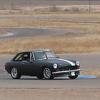After only 14 posts we now see why such a list doesn´t exist. It is like dyno numbers, if you haven´t seen the test personally don´t believe the data!! 
Here is an example torsional stiffness estimate:
An open-wheeled, mid-engined race vehicle was installed on Multimatic's four post rig. Springs/dampers were replaced by solid links, & wheel/tyres by replaced with "rigging" or "set-up" wheels. The vehicle was stabilized by attaching a lightly pressurized pneumatic actuator to the vehicle close to each axle. It was otherwise unconstrained.
The wheel actuators were driven in "warp" using a sinusoid of +/- 2mm amplitude & a frequency of approx 1/20 Hz. (requiring 18.75 secs to complete a cycle). Various measurements were recorded with a frame rate of 100 /sec. The time histories of differential actuator displacement ((Left - Right)/2) are shown below:
http://davew.webs.com/111811264463.pngThe corresponding differential contact patch load time histories were:
http://davew.webs.com/111811305156.pngMore interestingly, perhaps, the two parameters were plotted one against the other, to obtain the following trajectories:
http://davew.webs.com/111811310161.pngThe front axle trajectory is shown in red, the rear in green. The regression slope is recorded in the colour coded legends (813.31 N/mm front & 836.94 N/mm rear). The two estimates differ because the front and rear tracks were different. Multiplying by the appropriate track yields 1329.8 N.m/mm for the front axle & 1326.6 N.m/mm for the rear axle, which suggests a measurement/processing error of 0.24%, since the two should self-balance. Taking the average of the two estimates, the overall torsional stiffness was computed to be approx 9,300 N.m/deg. spindle-spindle.
Electronic inclinometers were attached to the vehicle at the nosebox bulkhead, and the rear wing lower element. Time histories generated by these are shown below:
http://davew.webs.com/111811240277.pngThe time histories were noisy because inclinometers are also very sensitive lateral accelerometers. The vehicle did not deflect in an entirely smooth way, despite the purity of the platform motion, so the measurements were corrupted by small accelerations.
The corresponding front axle differential load plotted against (front-rear) angular deflection follows:
http://davew.webs.com/111811311514.pngThe red dotted line shows the normal regression line (Slope of 10,115 N/deg.). The magnitude of the "noise" caused the regression slope to be biased. Arguably, a rather less biased estimate of slope can be obtained by "Fourier filtering" the measurements. The result is the green trajectory, with a regression slope of 11,113 N/deg., an increase of 10 percent. Further processing yielded an estimated torsional stiffness of the tub, engine & transmission (i.e. omitting the suspension) of approx 18,160 N.m/deg.
The test demonstrated that the torsional compliance was split fairly equally between the chassis and the suspension.
I think the example demonstrates a requirement for knowing test conditions, what was measured and how the results were processed.
p.s. 1 N.m = 0.738 lb.ft.
Edited by DaveW, 18 November 2009 - 20:45.




















